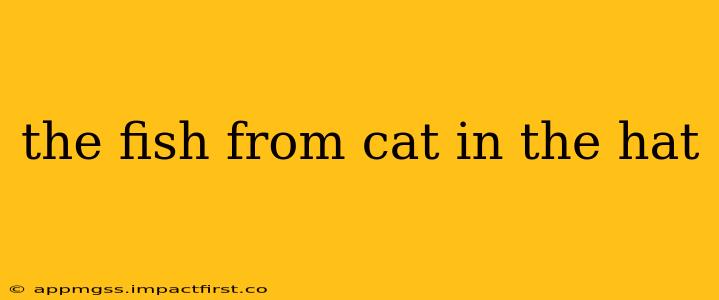Dr. Seuss's The Cat in the Hat is a beloved children's classic, filled with memorable characters and whimsical imagery. While the Cat himself steals the show, the small, gold-colored fish plays a surprisingly significant role, offering a moral compass and a voice of reason amidst the chaos. This seemingly simple character adds depth and complexity to the story, making him a fascinating subject for analysis. This post will explore the fish's significance, answering some common questions people have about this iconic character.
What is the Fish's Role in The Cat in the Hat?
The fish acts as the conscience of the story. He represents responsibility, caution, and adherence to rules. He’s the voice of reason, constantly warning against the Cat's disruptive and potentially dangerous antics. While the children are easily swayed by the Cat's charm and promises of fun, the fish provides a crucial counterpoint, highlighting the potential consequences of their actions. His repeated warnings, "Oh, no, no, no! I don't like that!" underscore the importance of following rules and considering the potential ramifications of one's choices.
Why is the Fish So Important to the Story?
Beyond his role as the voice of reason, the fish serves several important narrative functions. He provides comedic relief through his exasperated reactions to the Cat's shenanigans. He adds a layer of tension, creating a sense of anticipation and uncertainty as the children try to hide the chaos from their mother. Most importantly, the fish's presence reminds readers, especially children, that even amidst fun and excitement, it's essential to consider the consequences of one's actions and to listen to those who offer cautionary advice. He's a quiet hero, reminding us of the importance of responsibility and making smart decisions.
What Kind of Fish is the Goldfish in The Cat in the Hat?
While Dr. Seuss never explicitly states the type of fish, it's commonly interpreted as a goldfish due to its color and the general depiction of its bowl. Goldfish are popular household pets, fitting the context of the story. The ambiguity allows for a bit of imagination; it could be any small, gold-colored fish, leaving room for children's interpretations.
What Happens to the Fish at the End of The Cat in the Hat?
At the story's conclusion, the Cat and his chaotic contraptions vanish, leaving everything back to normal. The fish is left unharmed, his warning heeded (though perhaps temporarily forgotten by the children). He remains a silent observer, a symbol of order restored after the initial chaos. His presence, however, reinforces the message that responsibility and caution are important values to uphold, even after fun and exciting adventures have come to a close.
Is the Fish a Symbol of Something Bigger?
The fish can be interpreted as a symbol of the adult perspective, the voice of reason often disregarded by children caught up in the allure of fun and excitement. He represents the importance of adult supervision and guidance, providing a counterbalance to the Cat's unrestrained antics. Further, he could be seen as a representation of conscience, the inner voice that reminds us to think before we act.
Conclusion: The Unsung Hero of The Cat in the Hat
While the Cat in the Hat is undoubtedly the protagonist, the seemingly small role of the fish is crucial to the story’s success. He's a powerful symbol of responsibility, caution, and the importance of listening to the voices of reason, reminding readers of the need for balance and the consequences of our choices. His simple yet impactful presence elevates The Cat in the Hat beyond a simple children's story, making it a lasting classic that continues to resonate with readers of all ages.
